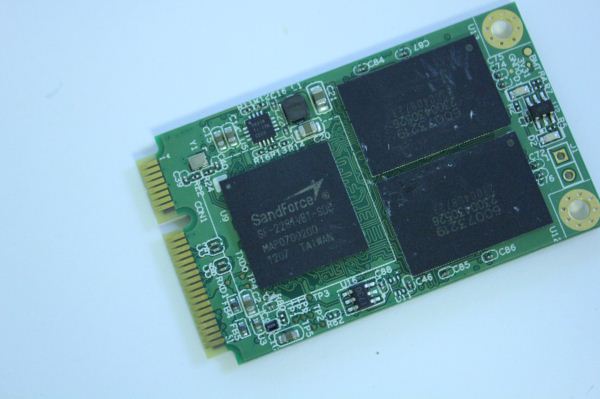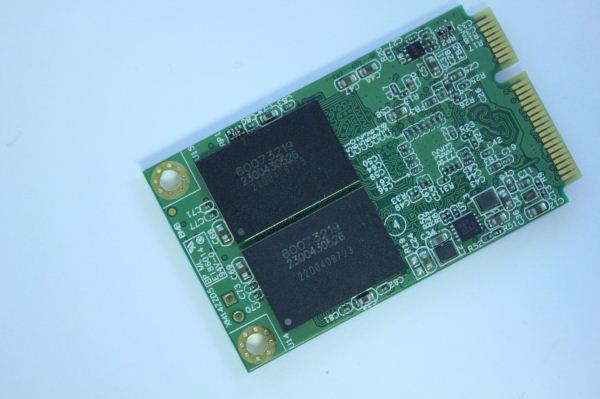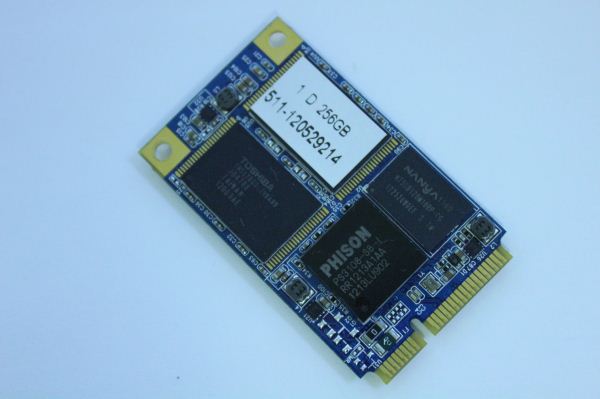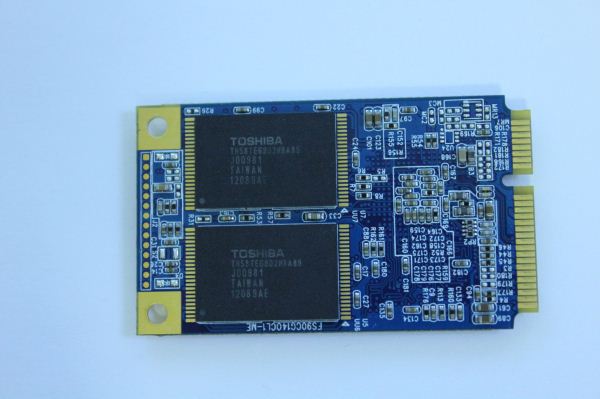MyDigitalSSD SMART & BP3 mSATA SSD Review
by Kristian Vättö on January 22, 2013 1:24 PM ESTMyDigitalSSD SMART
The heart of the SMART is SandForce's SF-2281 controller, which is used by dozens of manufacturers. SandForce doesn't use dedicated DRAM cache, leaving the controller and NAND as the only components on the PCB. The drive came with firmware 5.0.2a but there's a newer 5.0.4 available at MyDigitalSSD's website. I ran a few tests with the new firmware but didn't see any noticeable difference in performance so the scores you'll see are with the 5.0.2a firmware.
On the flip side we find another two NAND packages. These are all octo-die packages to yield the capacity of 256GB, which is currently the maximum for mSATA form factor (though Mushkin has announced a stacked mSATA design with up to 480GB). Once 128Gb dies start to make their way into the market sometime in 2013, we should see mSATA SSDs of up to 512GB without special designs.
The actual NAND in the SMART is a bit of a mystery. Googling the part number yields no results but from what I was able to find, it seems that the NAND is running in synchronous mode and manufactured using IMFT's 25nm process but packaged by ADATA (for example their SX300 uses the same NAND). The idea is that you buy whole wafers of NAND and then use your own binning methodology to pick the best dies. When you buy pre-packaged NAND, it's unlikely that you'll be getting the highest quality NAND because usually the manufacturer reserves that NAND for their own products. If you buy NAND in whole wafers, you will also get a small share of the highest quality chips, although you are also left with a big chunk of NAND that is not suitable for SSDs (but it may be fine for memory sticks and cards). This is a fairly common practice in the SSD industry and for example OCZ and Kingston do it as well.
It's unclear to me why MyDigitalSSD chose ADATA but the SMART is actually recognized as an ADATA SX300 by the system, so the SMART may be a rebrand of the SX300 or at least MyDigitalSSD has worked very closely with ADATA.
MyDigitalSSD BP3
Not much is known about Phison's PS3108 controller. Phison says the controller supports both SLC and MLC NAND, along with 1Xnm class NAND. The controller is fabricated using 55nm CMOS process, but the actual manufacturer is unknown. The controller is coupled with 256MB of DDR3-1333 DRAM from Nanya. The drive came with firmware version 3.2, which is currently the latest.
In the NAND department we have four of Toshiba's 24nm Togge-Mode MLC NAND packages, each consisting of eight 8GB dies yielding a total capacity of 64GB per package.
The motherboard in my testbed does not have an mSATA slot, so MyDigitalSSD also sent us an mSATA to 2.5" SATA adapter.
Test System
| CPU | Intel Core i5-2500K running at 3.3GHz (Turbo and EIST enabled) |
| Motherboard | AsRock Z68 Pro3 |
| Chipset | Intel Z68 |
| Chipset Drivers | Intel 9.1.1.1015 + Intel RST 10.2 |
| Memory | G.Skill RipjawsX DDR3-1600 2 x 4GB (9-9-9-24) |
| Video Card |
XFX AMD Radeon HD 6850 XXX (800MHz core clock; 4.2GHz GDDR5 effective) |
| Video Drivers | AMD Catalyst 10.1 |
| Desktop Resolution | 1920 x 1080 |
| OS | Windows 7 x64 |















49 Comments
View All Comments
philipma1957 - Tuesday, January 22, 2013 - link
The crucial mSata 256gb is pretty good for asrock z77-itx board and for intels h77 itx board.They allow for a small desktop. I would like the 3 mobos I used to allow sata III they only allow Sata II.
philipma1957 - Tuesday, January 22, 2013 - link
Follow upI have these mobos
ASRock Z77E-ITX LGA 1155 Intel Z77 HDMI SATA 6Gb/s USB 3.0 Mini ITX Intel Motherboard
Intel BOXDH77DF LGA 1155 Intel H77 HDMI SATA 6Gb/s USB 3.0 Mini ITX Intel Motherboard
ASUS Maximus V Gene LGA 1155 Intel Z77 HDMI SATA 6Gb/s USB 3.0 Micro ATX Intel Motherboard
all are running with just the crucial msata 256gb ssds .
I would not mind one with a Sata III slot , I do agree msata is not offered as viable option for the system builder.
Death666Angel - Tuesday, January 22, 2013 - link
All I could find is that mSATA is only specified for SATA 1.5Gb/s and SATA 3 Gb/s, not SATA 6 Gb/s.nathanddrews - Tuesday, January 22, 2013 - link
Forgive me if I missed it, but should there be a benchmark showing performance consistency when factoring 25% spare area? Given AT's recent affinity for such benchmarks, I now expect to see it in every SSD review./rabble rabble!
Kristian Vättö - Tuesday, January 22, 2013 - link
It's not something we test with every drive because for example all SandForce drives behave the same way. I've actually had these drives for nearly six months and tested them long ago but the write up was pushed back by more urgent reviews. I know I may sound lazy here, but I don't consider the BP3 or SMART to be the choice for many already given the fact that mSATA isn't very popular and I see the majority of buyers going with name brands, so I decided not to test performance consistency this time.The random write speed is rather slow to begin with, and it gets below 1MB/s when tortured.
fugu_ - Tuesday, January 22, 2013 - link
It would have been nice to see performance consistency benchmarks for the drive that used the Phison controller, especially since there are only a handful of options for ~250GB mSATA drives.It's great to see any sort of reviews of lesser known drives. At the same time, it's a little disappointing that the perceived popularity of these drives stopped you from doing a more complete review, especially if you've had them for 6 months.
Kristian Vättö - Tuesday, January 22, 2013 - link
Yeah, I know it's not a proper excuse. This spring will be quite busy for me though, have plenty of SSDs to review and at the same time I should study for matriculation exams as well as university entrance exams.I know I shouldn't be making excuses, but I hope you can relate to my situation. I try to cut as few corners as possible but performance consistency is just PITA to test (well, the actual testing is fine but making the graphs is just painful because Microsoft can't make Office that's fully compatible with Office for Mac... Anand does the graphs on Mac, so I have to do too or they won't be identical). After that it's time for awful HTML editing which I suck at, so that takes way more time than it should.
Per Hansson - Wednesday, January 23, 2013 - link
Well if this is the place where we ask you to do performance consistency tests before your exams I'm in :)I would just love to see how the most crappy SSD controller of all; the JMicron JMF602 fares in performance consistency.
I think it would be a nice thing to look back at with what we know today.
Shockingly SSD's based on such controllers are still being sold!
http://www.prisjakt.nu/kategori.php?k=893#rparams=...
lyeoh - Wednesday, January 23, 2013 - link
Yeah I'd like to see the performance consistency for the lower end or even crap SSDs.Maybe even a few conventional spinning platter hard drives- low, mid, high.
Kristian Vättö - Wednesday, January 23, 2013 - link
Unfortunately, I don't have any SSDs that old. The "worst" SSDs I have are Crucial v4, OCZ Agility 4 and Samsung SSD 470. I could definitely run something on the V4 and BP3 to see if Phison has done any progress in this matter.